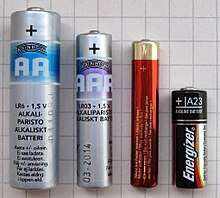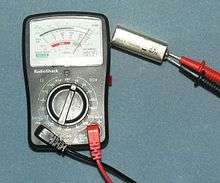Voltage
Voltage, electric potential difference, electric pressure or electric tension is the difference in electric potential between two points, which (in a static electric field) is defined as the work needed per unit of charge to move a test charge between the two points. In the International System of Units, the derived unit for voltage (potential difference) is named volt.[1]:166 In SI units, work per unit charge is expressed as joules per coulomb, where 1 volt = 1 joule (of work) per 1 coulomb (of charge). The old SI definition for volt used power and current, since 1990 quantum Hall and Josephson effect were used and recently (2019) fundamental physical constants were introduced for the definition of all SI units and derived units.[1]:177f, 197f Voltage or electric potential difference is denoted symbolically by ∆V, simplified V,[2] or U,[3] for instance in the context of Ohm's or Kirchhoff's circuit laws.
| Voltage | |
|---|---|
 Batteries are sources of voltage in many electric circuits. | |
Common symbols | V , ∆V , U , ∆U |
| SI unit | volt |
Derivations from other quantities | Voltage = Energy / charge |
| Dimension | M L2 T−3 I−1 |
Electric potential differences between points can be caused by electric charge, by electric current through a magnetic field, by time-varying magnetic fields, or some combination of these three.[4][5] A voltmeter can be used to measure the voltage (or potential difference) between two points in a system; often a common reference potential such as the ground of the system is used as one of the points. A voltage may represent either a source of energy (electromotive force) or lost, used, or stored energy (potential drop).
Definition
There are multiple useful ways to define voltage, including the standard definition mentioned at the start of this page. There are also other useful definitions of work per charge (see this section).
Voltage is defined so that negatively charged objects are pulled towards higher voltages, while positively charged objects are pulled towards lower voltages. Therefore, the conventional current in a wire or resistor always flows from higher voltage to lower voltage.
Historically, voltage has been referred to using terms like "tension" and "pressure". Even today, the term "tension" is still used, for example within the phrase "high tension" (HT) which is commonly used in thermionic valve (vacuum tube) based electronics.
Definition as potential of electric field
The voltage increase from some point to some point is given by

In this case, the voltage increase from point A to point B is equal to the work done per unit charge, against the electric field, to move the charge from A to B without causing any acceleration. Mathematically, this is expressed as the line integral of the electric field along that path. Under this definition, the voltage difference between two points is not uniquely defined when there are time-varying magnetic fields since the electric force is not a conservative force in such cases.

If this definition of voltage is used, any circuit where there are time-varying magnetic fields,[note 1] such as circuits containing inductors, will not have a well-defined voltage between nodes in the circuit. However, if magnetic fields are suitably contained to each component, then the electric field is conservative in the region exterior[note 2] to the components, and voltages are well-defined in that region.[6] In this case, the voltage across an inductor, viewed externally, turns out to be
despite the fact that, internally, the electric field in the coil is zero[6] (assuming it is a perfect conductor).
Definition via decomposition of electric field
Using the above definition, the electric potential is not defined whenever magnetic fields change with time. In physics, it's sometimes useful to generalize the electric potential by only considering the conservative part of the electric field. This is done by the following decomposition used in electrodynamics:
where is the magnetic vector potential. The above decomposition is justified by Helmholtz's theorem.
In this case, the voltage increase from to is given by
where is the rotational electric field due to time-varying magnetic fields. In this case, the voltage between points is always uniquely defined.
Treatment in circuit theory
In circuit analysis and electrical engineering, the voltage across an inductor is not considered to be zero or undefined, as the standard definition would suggest. This is because electrical engineers use a lumped element model to represent and analyze circuits.
When using a lumped element model, it is assumed that there are no magnetic fields in the region surrounding the circuit and that the effects of these are contained in 'lumped elements', which are idealized and self-contained circuit elements used to model physical components.[7] If the assumption of negligible leaked fields is too inaccurate, their effects can be modelled by parasitic components.
In the case of a physical inductor though, the ideal lumped representation is often accurate. This is because the leaked fields of the inductor are generally negligible, especially if the inductor is a toroid. If leaked fields are negligible, we find that
is path-independent, and there is a well-defined voltage across the inductor's terminals.[6] This is the reason that measurements with a voltmeter across an inductor are often reasonably independent of the placement of the test leads.
Volt
The volt (symbol: V) is the derived unit for electric potential, electric potential difference, and electromotive force. The volt is named in honour of the Italian physicist Alessandro Volta (1745–1827), who invented the voltaic pile, possibly the first chemical battery.
Hydraulic analogy
A simple analogy for an electric circuit is water flowing in a closed circuit of pipework, driven by a mechanical pump. This can be called a "water circuit". Potential difference between two points corresponds to the pressure difference between two points. If the pump creates a pressure difference between two points, then water flowing from one point to the other will be able to do work, such as driving a turbine. Similarly, work can be done by an electric current driven by the potential difference provided by a battery. For example, the voltage provided by a sufficiently-charged automobile battery can "push" a large current through the windings of an automobile's starter motor. If the pump isn't working, it produces no pressure difference, and the turbine will not rotate. Likewise, if the automobile's battery is very weak or "dead" (or "flat"), then it will not turn the starter motor.
The hydraulic analogy is a useful way of understanding many electrical concepts. In such a system, the work done to move water is equal to the pressure multiplied by the volume of water moved. Similarly, in an electrical circuit, the work done to move electrons or other charge-carriers is equal to "electrical pressure" multiplied by the quantity of electrical charges moved. In relation to "flow", the larger the "pressure difference" between two points (potential difference or water pressure difference), the greater the flow between them (electric current or water flow). (See "electric power".)
Applications
_Hawaii_reconfigure_electrical_circuitry_and.jpg)
Specifying a voltage measurement requires explicit or implicit specification of the points across which the voltage is measured. When using a voltmeter to measure potential difference, one electrical lead of the voltmeter must be connected to the first point, one to the second point.
A common use of the term "voltage" is in describing the voltage dropped across an electrical device (such as a resistor). The voltage drop across the device can be understood as the difference between measurements at each terminal of the device with respect to a common reference point (or ground). The voltage drop is the difference between the two readings. Two points in an electric circuit that are connected by an ideal conductor without resistance and not within a changing magnetic field have a voltage of zero. Any two points with the same potential may be connected by a conductor and no current will flow between them.
Addition of voltages
The voltage between A and C is the sum of the voltage between A and B and the voltage between B and C. The various voltages in a circuit can be computed using Kirchhoff's circuit laws.
When talking about alternating current (AC) there is a difference between instantaneous voltage and average voltage. Instantaneous voltages can be added for direct current (DC) and AC, but average voltages can be meaningfully added only when they apply to signals that all have the same frequency and phase.
Measuring instruments

Instruments for measuring voltages include the voltmeter, the potentiometer, and the oscilloscope. Analog voltmeters, such as moving-coil instruments, work by measuring the current through a fixed resistor, which, according to Ohm's Law, is proportional to the voltage across the resistor. The potentiometer works by balancing the unknown voltage against a known voltage in a bridge circuit. The cathode-ray oscilloscope works by amplifying the voltage and using it to deflect an electron beam from a straight path, so that the deflection of the beam is proportional to the voltage.
Typical voltages
A common voltage for flashlight batteries is 1.5 volts (DC). A common voltage for automobile batteries is 12 volts (DC).
Common voltages supplied by power companies to consumers are 110 to 120 volts (AC) and 220 to 240 volts (AC). The voltage in electric power transmission lines used to distribute electricity from power stations can be several hundred times greater than consumer voltages, typically 110 to 1200 kV (AC).
The voltage used in overhead lines to power railway locomotives is between 12 kV and 50 kV (AC) or between 0.75 kV and 3 kV (DC).
Galvani potential vs. electrochemical potential
Inside a conductive material, the energy of an electron is affected not only by the average electric potential, but also by the specific thermal and atomic environment that it is in. When a voltmeter is connected between two different types of metal, it measures not the electrostatic potential difference, but instead something else that is affected by thermodynamics.[8] The quantity measured by a voltmeter is the negative of the difference of the electrochemical potential of electrons (Fermi level) divided by the electron charge and commonly referred to as the voltage difference, while the pure unadjusted electrostatic potential (not measurable with a voltmeter) is sometimes called Galvani potential. The terms "voltage" and "electric potential" are ambiguous in that, in practice, they can refer to either of these in different contexts.
History
The term electromotive force was first used by Volta in a letter to Giovanni Aldini in 1798, and first appeared in a published paper in 1801 in Annales de chimie et de physique.[9]:408 Volta meant by this a force that was not an electrostatic force, specifically, an electrochemical force.[9]:405 The term was taken up by Michael Faraday in connection with electromagnetic induction in the 1820s. However, a clear definition of voltage and method of measuring it had not been developed at this time.[10]:554 Volta distinguished electromotive force (emf) from tension (potential difference): the observed potential difference at the terminals of an electrochemical cell when it was open circuit must exactly balance the emf of the cell so that no current flowed.[9]:405
See also
- Alternating current (AC)
- Direct current (DC)
- Electric potential
- Electric shock
- Electrical measurements
- Electrochemical potential
- Fermi level
- High voltage
- Mains electricity (an article about domestic power supply voltages)
- Mains electricity by country (list of countries with mains voltage and frequency)
- Ohm's law
- Ohm
- Open-circuit voltage
- Phantom voltage
References
- International Bureau of Weights and Measures (2019-05-20), SI Brochure: The International System of Units (SI) (PDF) (9th ed.), ISBN 978-92-822-2272-0
- IEV: electric potential
- IEV: voltage
- Demetrius T. Paris and F. Kenneth Hurd, Basic Electromagnetic Theory, McGraw-Hill, New York 1969, ISBN 0-07-048470-8, pp. 512, 546
- P. Hammond, Electromagnetism for Engineers, p. 135, Pergamon Press 1969 OCLC 854336.
- R. Feynman; et al. "The Feynman Lectures on Physics Vol. II Ch. 22: AC Circuits". Caltech. Retrieved 4 December 2018.
- A. Agarwal & J. Lang (2007). "Course materials for 6.002 Circuits and Electronics" (PDF). MIT OpenCourseWare. Retrieved 4 December 2018.
- Bagotskii, Vladimir Sergeevich (2006). Fundamentals of electrochemistry. p. 22. ISBN 978-0-471-70058-6.
- Robert N. Varney, Leon H. Fisher, "Electromotive force: Volta's forgotten concept", American Journal of Physics, vol. 48, iss. 5, pp. 405–408, May 1980.
- C. J. Brockman, "The origin of voltaic electricity: The contact vs. chemical theory before the concept of E. M. F. was developed", Journal of Chemical Education, vol. 5, no. 5, pp. 549–555, May 1928
Footnotes
- If there are time-varying electric fields or accelerating charges, then there will be time-varying magnetic fields. This means in AC circuits, there are always some non-confined magnetic fields. However, except at higher frequencies, these are neglected.
- This relies on the fact that each component has a finite volume. If a component had an infinite extent, the region exterior to the components would not be simply connected, and thus integrals through it would still depend on the path taken.
External links
| Look up voltage in Wiktionary, the free dictionary. |
